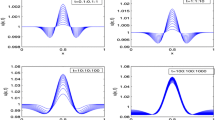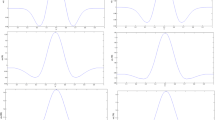Abstract
In this paper, the spectral meshless radial point interpolation (SMRPI) technique is applied to a mathematical model for two-dimensional capillary formation model in tumor angiogenesis problem. This is a natural continuation of capillary formation in tumor angiogenesis (Shivanian and Jafarabadi in Eng Comput 34:603–619, 2018), where the capillary (1D problem) has been considered. The mathematical model describes the progression of tumor angiogenic factor in a unit square space domain, namely the extracellular matrix. First, we obtain a time discrete scheme by approximating time derivative via a finite difference formula, and then, we use the SMRPI approach to approximate the spatial derivatives. This approach is based on a combination of meshless methods and spectral collocation techniques. The point interpolation method with the help of radial basis functions is used to construct shape functions which act as basis functions in the frame of SMRPI. Because of non-availability of the exact solution, we consider two strategies for checking the stability of time difference scheme and for survey the convergence of the fully discrete scheme. The obtained numerical results show that the SMRPI provides high accuracy and efficiency with respect to the other classical methods in the literature.









Similar content being viewed by others
References
Shivanian E, Jafarabadi A (2018) Capillary formation in tumor angiogenesis through meshless weak and strong local radial point interpolation. Eng Comput 34:603–619
Folkman J (1971) Tumor angiogenesis: therapeutic implications. N Engl J Med 285(21):1182–1186
Folkman J (1984) Biology of endothelial cells, vol 27. Springer, Boston, MA, pp 412–428
Emamjome M, Azarnavid B, Roohani Ghehsareh H (2017) A reproducing kernel Hilbert space pseudospectral method for numerical investigation of a two-dimensional capillary formation model in tumor angiogenesis problem. Neural Comput Appl 9:1–9
Levine HA, Pamuk S, Sleeman BD, Nilsen-Hamilton M (2001) Mathematical modeling of capillary formation and development in tumor angiogenesis: penetration into the stroma. Bull Math Biol 63(5):801–863
Pamuk S, Erdem A (2007) The method of lines for the numerical solution of a mathematical model for capillary formation: the role of endothelial cells in the capillary. Appl Math Comput 186(1):831–835
Saadatmandi A, Dehghan M (2008) Numerical solution of a mathematical model for capillary formation in tumor angiogenesis via the Tau method. Commun Numer Methods Eng 24(11):1467–1474
Gücüyenen N, Tanoğlu G (2011) Iterative operator splitting method for capillary formation model in tumor angiogenesis problem: analysis and application. Int J Numer Methods Biomed Eng 27(11):1740–1750
Pamuk S (2004) Steady-state analysis of a mathematical model for capillary network formation in the absence of tumor source. Math Biosci 189(1):21–38
Nayroles B, Touzot G, Villon P (1992) Generalizing the finite element method: diffuse approximation and diffuse elements. Comput Mech 10(5):307–318
Belytschko T, Lu YY, Gu L (1994) Element-free Galerkin methods. Int J Numer Methods Eng 37(2):229–256
Dehghan M, Abbaszadeh M (2016) Variational multiscale element free Galerkin (VMEFG) and local discontinuous Galerkin (LDG) methods for solving two-dimensional Brusselator reaction-diffusion system with and without cross-diffusion. Comput Methods Appl Mech Eng 300:770–797
Atluri SN, Zhu T (1998) A new meshless local Petrov–Galerkin (MLPG) approach in computational mechanics. Comput Mech 22(2):117–127
Shivanian E (2015) Meshless local Petrov–Galerkin ( MLPG) method for three-dimensional nonlinear wave equations via moving least squares approximation. Eng Anal Bound Elem 50:249–257
Liu GR, Zhang GY, Dai KY, Wang YY, Zhong ZH, Li GY, Han X (2005) A linearly conforming point interpolation method (LC-PIM) for 2D solid mechanics problems. Int J Comput Methods 2(04):645–665
Dehghan M, Abbaszadeh M, Mohebbi A (2015) A meshless technique based on the local radial basis functions collocation method for solving parabolic-parabolic Patlak–Keller–Segel chemotaxis model. Eng Anal Bound Elem 56:129–144
Dehghan M, Haghjoo-Saniji M (2017) The local radial point interpolation meshless method for solving Maxwell equations. Eng Comput 33(4):897–918
Hosseini VR, Shivanian E, Chen W (2015) Local integration of 2-D fractional telegraph equation via local radial point interpolant approximation. Eur Phys J Plus 130:33:1–21
Shivanian E, Abbasbandy S, Alhuthali MS, Alsulami HH (2015) Local integration of 2-d fractional telegraph equation via moving least squares approximation. Eng Anal Bound Elem 56:98–105
Hosseini VR, Shivanian E, Chen W (2016) Local radial point interpolation (mlrpi) method for solving time fractional diffusion-wave equation with damping. J Comput Phys 312:307–332
Abbasbandy S, Shivanian E (2016) Numerical simulation based on meshless technique to study the biological population model. Math Sci 10(3):123–130
Abbasbandy S, Shivanain E (2015) The effects of mhd flow of third grade fluid by means of meshless local radial point interpolation (MLRPI). Int J Ind Math 7(1):1–11
Shivanian E, Jafarabadi A (2018) The numerical solution for the time-fractional inverse problem of diffusion equation. Eng Anal Bound Elem 91:50–59
Lucy LB (1977) A numerical approach to the testing of the fission hypothesis. Astron J 82:1013–1024
Liu GR, Xu GX (2008) A gradient smoothing method (GSM) for fluid dynamics problems. Int J Numer Methods Fluids 58(10):1101–1133
Onate E, Idelsohn S, Zienkiewicz OC, Taylor RL (1996) A finite point method in computational mechanics. Applications to convective transport and fluid flow. Int J Numer Methods Eng 39(22):3839–3866
Liszka T, Orkisz J (1980) The finite difference method at arbitrary irregular grids and its application in applied mechanics. Comput Struct 11(1–2):83–95
Liu GR, Kee BBT, Chun L (2006) A stabilized least-squares radial point collocation method (LS-RPCM) for adaptive analysis. Comput Methods Appl Mech Eng 195(37):4843–4861
Liu GR, Gu YT (2003) A meshfree method: meshfree weak-strong (MWS) form method, for 2-D solids. Comput Mech 33(1):2–14
Mukherjee YX, Mukherjee S (1997) The boundary node method for potential problems. Int J Numer Methods Eng 40(5):797–815
Shivanian E (2015) A new spectral meshless radial point interpolation (SMRPI) method: a well-behaved alternative to the meshless weak forms. Eng Anal Bound Elem 54:1–12
Shivanian E, Jafarabadi A (2017) Numerical solution of two-dimensional inverse force function in the wave equation with nonlocal boundary conditions. Inverse Probl Sci Eng 25(12):1743–1767
Shivanian E, Jafarabadi A (2018) The spectral meshless radial point interpolation method for solving an inverse source problem of the time-fractional diffusion equation. Appl Numer Math 129:1–25
Erdem A, Pamuk S (2007) The method of lines for the numerical solution of a mathematical model for capillary formation: the role of tumor angiogenic factor in the extra-cellular matrix. Appl Math Comput 186(1):891–897
Shivanian E (2016) Spectral meshless radial point interpolation (SMRPI) method to two-dimensional fractional telegraph equation. Math Methods Appl Sci 39(7):1820–1835
Dehghan M, Ghesmati A (2010) Numerical simulation of two-dimensional sine-Gordon solitons via a local weak meshless technique based on the radial point interpolation method (RPIM). Comput Phys Commun 181(4):772–786
Dehghan M, Abbaszadeh M, Mohebbi A (2016) The use of element free Galerkin method based on moving Kriging and radial point interpolation techniques for solving some types of Turing models. Eng Anal Bound Elem 62:93–111
Hardy RL (1971) Multiquadric equations of topography and other irregular surfaces. J Geophys Res 76(8):1905–1915
Hardy RL (1990) Theory and applications of the multiquadric-biharmonic method 20 years of discovery 1968–1988. Comput Math Appl 19(8):163–208
Franke R (1982) Scattered data interpolation: tests of some methods. Math Comput 38(157):181–200
Fasshauer GE (2002) Newton iteration with multiquadrics for the solution of nonlinear pdes. Comput Mathe Appl 43(3):423–438
Kansa EJ (1990) Multiquadrics—a scattered data approximation scheme with applications to computational fluid-dynamics—ii solutions to parabolic, hyperbolic and elliptic partial differential equations. Comput Math Appl 19(8):147–161
Sarra SA, Sturgill D (2009) A random variable shape parameter strategy for radial basis function approximation methods. Eng Anal Bound Elem 33(11):1239–1245
Dehghan M, Abbaszadeh M, Mohebbi A (2014) The numerical solution of nonlinear high dimensional generalized Benjamin–Bona-Mahony–Burgers equation via the meshless method of radial basis functions. Comput Math Appl 68(3):212–237
Acknowledgements
The authors are grateful to the reviewers for carefully reading this paper and for their comments and suggestions which have improved the paper. The second author dedicates this article to Mohammad Reza Shajarian, internationally and critically acclaimed Iranian classical singer, composer, and Ostad (master) of Persian traditional music.
Author information
Authors and Affiliations
Corresponding author
Additional information
Publisher's Note
Springer Nature remains neutral with regard to jurisdictional claims in published maps and institutional affiliations.
Rights and permissions
About this article
Cite this article
Shivanian, E., Jafarabadi, A. Two-dimensional capillary formation model in tumor angiogenesis problem through spectral meshless radial point interpolation. Engineering with Computers 36, 127–138 (2020). https://doi.org/10.1007/s00366-018-0689-0
Received:
Accepted:
Published:
Issue Date:
DOI: https://doi.org/10.1007/s00366-018-0689-0




